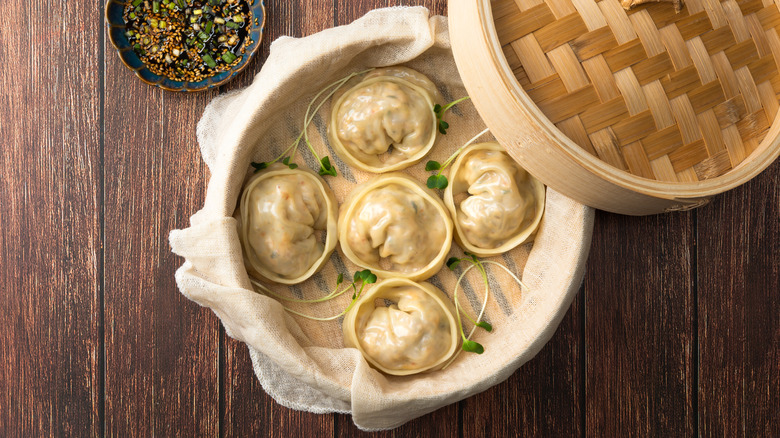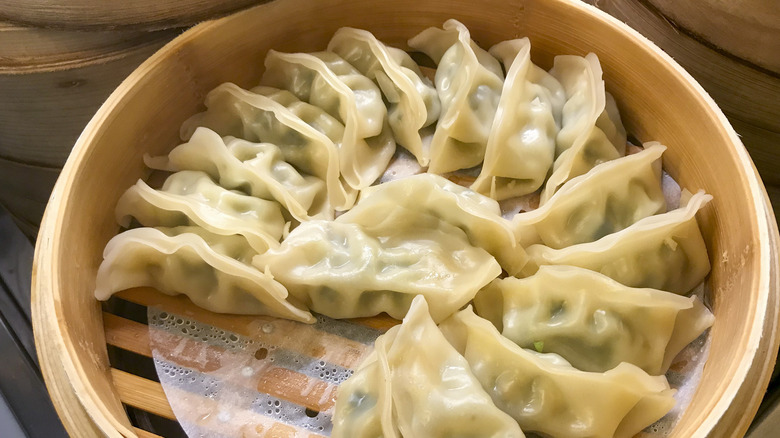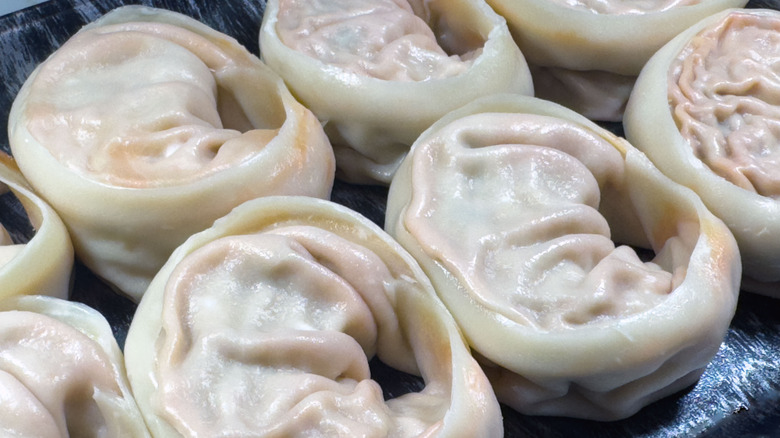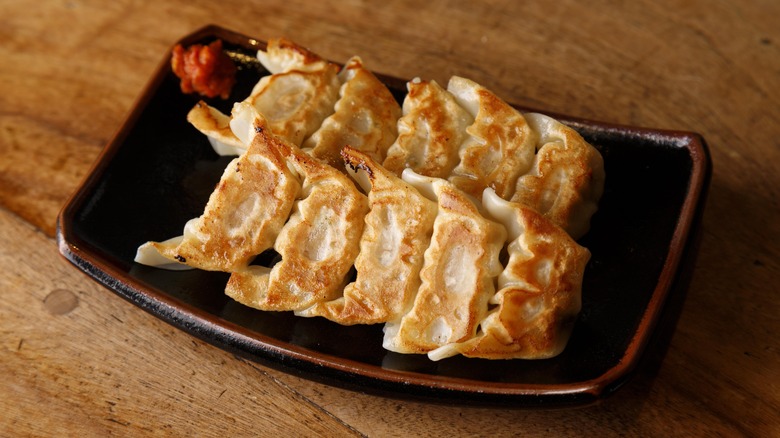The Difference Between Korean And Chinese Dumplings
A dumpling by any name would still taste as sweet ... right? Maybe the Shakespearean paraphrase doesn't work quite as well when you're talking about savory foods. Either way, ask any diehard dumpling lover: All dumplings are not created equal. From different wrappers (chewy or thin) to different cooking methods and different filling ingredients, it pays to know what your versatile little pocket is all about — especially since dumplings are such a labor-intensive treat to make by hand. It's lucky that so many quick-service dumpling shops have cropped up in the U.S. to give foodies an affordable taste of the good stuff without all the labor (we've rounded up a few of our favorite shops in New York City, if you're hungry to try 'em for yourself). That's why, today, we're deep-diving into two of the most well-known types of dumplings – Korean and Chinese — and exploring what makes them unique.
Both can be steamed, deep fried, pan fried, boiled, added to soups (like these Pork and Chive Dumplings in Garlic-Miso Broth), or served as an appetizer. They even bear nearly identical ingredients lists. But, while the differences between Chinese and Korean dumplings may be nuanced, they are hugely impactful to the overall bite and flavor. Perhaps the most obvious distinction is their shape, but their individuality is more than just skin (or wrapper) deep.
What are Korean dumplings?
Korean dumplings are called "mandu," a word which means "meat-filled dumpling." Don't let this title mislead you. Savory vegetarian fillings are popular, as well. Korean mandu is typically filled with ground pork, tofu, ginger, and buchu (Korean garlic chives). A common vegetarian version called yachae mandu is stuffed with tofu, chopped cabbage, carrots, sweet potatoes, shiitake peppers, and pre-cooked mung bean noodles. Other common mandu filling ingredients include baechu (aka napa cabbage), kimchi, zucchini, mushrooms, bean sprouts, onion, Asian leeks, and chewy glass noodles called dangmyun.
Along with steaming, boiling, and frying, mandu are often added to a Korean dumpling soup with beef or anchovy broth called mandu guk, which is mixed with a beaten egg and served alongside tteok mandu guk, traditional sliced rice cakes. On their own, mandu are served pan-fried until golden brown and dipped in soy sauce, and they are sold by street vendors and fancy sit-down restaurants alike. At home, making massive batches of mandu in bulk (think hundreds of dumplings) can be a social activity, bringing friends and neighbors into the kitchen together. You can batch 'em ahead of time and freeze them for easy access in future meals.
What are Chinese dumplings?
The sprawling Unofficial Oeuvre of Chinese Dumplings also includes open-faced siu mai, bao, xiao long bao (aka soup dumplings), pot stickers, har gow crystal shrimp dumplings, and more. But, right now, we're specifically talking about jiǎozi (餃子) — the quintessential Chinese dumpling that started the international, multicultural dumpling mania to begin with. In fact, "jiaozi" is the Mandarin word for "dumpling." Jianjiao pan-fried jiaozi are what's commonly called potstickers.
Jiaozi are crescent-shaped dumplings made from a wheat dough wrapper with sealed, pleated edges. Fillings include Chinese rice wine or dry sherry, bamboo shoots, garlic, ginger, and ground meat. Some folks recommend meat with a fat content of 30% or more for a rich, moist bite. Notably, jiaozi utilize largely similar filling ingredients as mandu, like zucchini, carrot, lamb, pork, napa cabbage, and shiitake mushrooms. However, there is one veggie that belongs to the jiaozi camp alone.
It's a leafy green vegetable known as ji cai ("Shepherd's Purse"), and it's not commonly found outside of China beyond the frozen section in specialty Asian grocery stores. If you can't track down any ji cai, then baby bok choy, napa cabbage, and Chinese chives can all get the job done. Fried, crispy-skirted jiaozi are often served with spicy chili oil and Chinese black vinegar for dipping.
Mandu are typically rounded off, while jiaozi are half-moon shaped
Korean dumplings start with thin flour wrappers called mandu pi, which get filled and folded into a half-moon shape. People may also prepare them with or without pleats. The mandu pi can be homemade, or refrigerated store-bought gyoza or wonton wrappers with a 5-inch diameter will also get the job done. Beef and pork are two of the most popular varieties in Korea, and some recipes call for a combination of both meats.
To assemble mandu, all the ingredients are finely chopped and mashed together in a mixing bowl. Then, a small dollop of the filling is spooned into the center of a dumpling wrapper, folded in half, and gently pleated along the edges to seal, with the two furthest edges being connected to round off the dumpling. The edges of the dumpling wrappers need to be slightly wet to make them pliable and adhere together once folded.
Not dissimilar to mandu, to assemble jiaozi, a small scoop of filling is placed in the center of the dumpling wrapper (store-bought is totally fine), and the skin is folded over twice on each side, creating a sealed, fan-like shape. There is, however, one small but major difference. Mandu is folded in a way that creates a distinctly more circular shape.
Jiaozi is much older than mandu
Jiaozi has been around for over 1,800 years, invented during the Han Dynasty and pre-dating its Japanese counterpart gyoza by centuries. Gyoza didn't enter the scene until World War II when Japanese soldiers encountered dumplings in Manchuria, a region in Northeast China. Italian ravioli, Polish pierogi, and Russian pelmeni all have the anestral jiaozi to thank. In fact, per the lore, the traditional Korean dish mandu is actually a direct descendant of the Chinese dumpling, which was believed to have been brought from China to Korea through the Middle East, although it isn't clear exactly clear when the proto-mandu would have made its initial trek.
Still, even though jiaozi has enjoyed a much longer run than mandu, its shorter tenure hasn't stopped the Korean dumpling from taking on an important significance on cultural holidays. The Korean bulk dumpling-making party becomes festive during certain times of year, as mandu are prepared by families for the Korean Lunar New Year holiday to welcome good luck. A traditional holiday table spread features Korean pork mandu dumplings alongside tteokguk (Korean rice cake soup) and galbi-jjim (Korean braised ribs), or another protein like bulgogi or japchae.
Mandu fillings vary by taste preference, while jiaozi fillings have different regional and symbolic meanings
Like mandu, boiled jiaozi are a fixture on the Chinese New Year table as a symbol of prosperity. Their shape is meant to resemble the Chinese gold ingot, an ancient currency. In China's Northern provinces, the bulk dumpling-making party remains an important family activity for celebrating Chinese New Year. Although, year-round, jiaozi take on a more symbolic importance for foodies in China than the mandu of Korea.
Mandu filling ranges widely based on personal recipe or taste preference. In China, jiaozi filling tends to vary by region, with some provinces favoring pork, beef, lamb, or no meat at all. Jiaozi made in the Northern provinces also tends to have a thicker, chewier wrapper, while the Southern provinces favor thinner dumplings wrappers. Jiaozi is regularly enjoyed across the country from Hong Kong to Beijing, Turpan, Xi'an, Guangzhou, Shanghai, and more. In China, each type of filling also carries a traditional significance. Beef and mushroom fillings are associated with prosperity and fortune, fish filling is thought to welcome financial abundance, and cabbage brings good luck, to name a few.





